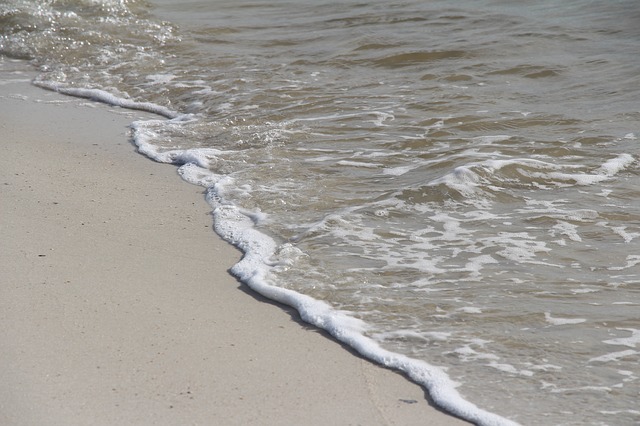9.5: Tidal Waves
- Page ID
- 12844
 Tides are the daily rise and fall of sea level at any given place. The pull of the Moon’s gravity on Earth is the primarily cause of tides and the pull of the Sun’s gravity on Earth is the secondary cause. The Moon has a greater effect because, although it is much smaller than the Sun, it is much closer. The Moon’s pull is about twice that of the Sun’s.
Tides are the daily rise and fall of sea level at any given place. The pull of the Moon’s gravity on Earth is the primarily cause of tides and the pull of the Sun’s gravity on Earth is the secondary cause. The Moon has a greater effect because, although it is much smaller than the Sun, it is much closer. The Moon’s pull is about twice that of the Sun’s.
Daily Tide Patterns
To understand the tides it is easiest to start with the effect of the Moon on Earth. As the Moon revolves around our planet, its gravity pulls Earth toward it. The lithosphere is unable to move much but the water above it is pulled by the gravity and a bulge is created. This bulge is the high tide beneath the Moon. The Moon’s gravity then pulls the Earth toward it, leaving the water on the opposite side of the planet behind. This creates a second high tide bulge on the opposite side of Earth from the Moon. These two water bulges on opposite sides of the Earth aligned with the Moon are the high tides. Click here to learn more.Since so much water is pulled into the two high tides, low tides form between the two high tides. As the Earth rotates beneath the Moon, a single spot will experience two high tides and two low tides every day.The tidal range is the difference between the ocean level at high tide and the ocean at low tide. The tidal range in a location depends on a number of factors, including the slope of the seafloor. Water appears to move a greater distance on a gentle slope than on a steep slope.

Monthly Tidal Patterns
Waves are additive so when the gravitational pull of the Sun and Moon are in the same direction, the high tides add and the low tides add. Highs are higher and lows are lower than at other times through the month. These more extreme tides, with a greater tidal range, are called spring tides. Spring tides don’t just occur in the spring; they occur whenever the Moon is in a new-moon or full-moon phase, about every 14 days. The National Oceanic and Atmospheric Administration (NOAA) has a simple diagram of this process.
Neap tides are tides that have the smallest tidal range, and they occur when the Earth, the Moon, and the Sun form a 90 degree angle. They occur exactly halfway between the spring tides, when the Moon is at first or last quarter. How do the tides add up to create neap tides? The Moon’s high tide occurs in the same place as the Sun’s low tide and the Moon’s low tide in the same place as the Sun’s high tide. At neap tides, the tidal range relatively small. Here is another simple animation of spring and neap tides from NOAA.High tides occur about twice a day, about every 12 hours and 25 minutes. The reason is that the Moon takes 24 hours and 50 minutes to rotate once around the Earth so the Moon is over the same location 24 hours and 50 minutes later. Since high tides occur twice a day, one arrives each 12 hours and 25 minutes. What is the time between a high tide and the next low tide? This animation shows the effect of the Moon and Sun on the tides.

Some coastal areas do not follow this pattern at all. These coastal areas may have one high and one low tide per day or a different amount of time between two high tides. These differences are often because of local conditions, such as the shape of the coastline that the tide is entering.
- Dynamic Earth: Introduction to Physical Geography. Authored by: R. Adam Dastrup. Located at: http://www.opengeography.org/physical-geography.html. Project: Open Geography Education. License: CC BY-SA: Attribution-ShareAlike
- Ocean Beach Water. Provided by: Max Pixel. Located at: http://maxpixel.freegreatpicture.com/Ocean-Beach-Water-Foam-Waves-Surf-Sea-Tide-1863497. License: CC0: No Rights Reserved
- High tide sun moon opposite side. Authored by: Lookang. Located at: https://commons.wikimedia.org/wiki/File:High_tide_sun_moon_opposite_side.png. License: CC BY-SA: Attribution-ShareAlike
- Low tide sun moon 270 degrees. Authored by: Lookang. Located at: https://commons.wikimedia.org/wiki/File:Low_tide_sun_moon_270_degrees.png. License: CC BY-NC-SA: Attribution-NonCommercial-ShareAlike

